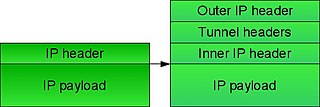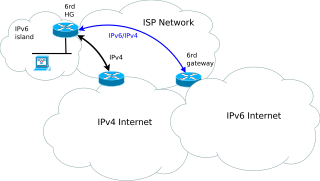Related Research Articles
An Internet Protocol address is a numerical label such as 192.0.2.1 that is assigned to a device connected to a computer network that uses the Internet Protocol for communication. IP addresses serve two main functions: network interface identification, and location addressing.

Internet Protocol version 6 (IPv6) is the most recent version of the Internet Protocol (IP), the communications protocol that provides an identification and location system for computers on networks and routes traffic across the Internet. IPv6 was developed by the Internet Engineering Task Force (IETF) to deal with the long-anticipated problem of IPv4 address exhaustion, and was intended to replace IPv4. In December 1998, IPv6 became a Draft Standard for the IETF, which subsequently ratified it as an Internet Standard on 14 July 2017.
The Internet Protocol (IP) is the network layer communications protocol in the Internet protocol suite for relaying datagrams across network boundaries. Its routing function enables internetworking, and essentially establishes the Internet.
In computer networking, the User Datagram Protocol (UDP) is one of the core communication protocols of the Internet protocol suite used to send messages to other hosts on an Internet Protocol (IP) network. Within an IP network, UDP does not require prior communication to set up communication channels or data paths.
Open Shortest Path First (OSPF) is a routing protocol for Internet Protocol (IP) networks. It uses a link state routing (LSR) algorithm and falls into the group of interior gateway protocols (IGPs), operating within a single autonomous system (AS).
A virtual private network (VPN) is a mechanism for creating a secure connection between a computing device and a computer network, or between two networks, using an insecure communication medium such as the public Internet.
In Internet networking, a private network is a computer network that uses a private address space of IP addresses. These addresses are commonly used for local area networks (LANs) in residential, office, and enterprise environments. Both the IPv4 and the IPv6 specifications define private IP address ranges.
6to4 is an Internet transition mechanism for migrating from Internet Protocol version 4 (IPv4) to version 6 (IPv6) and a system that allows IPv6 packets to be transmitted over an IPv4 network without the need to configure explicit tunnels. Special relay servers are also in place that allow 6to4 networks to communicate with native IPv6 networks.
Mobile IP is an Internet Engineering Task Force (IETF) standard communications protocol that is designed to allow mobile device users to move from one network to another while maintaining a permanent IP address. Mobile IP for IPv4 is described in IETF RFC 5944, and extensions are defined in IETF RFC 4721. Mobile IPv6, the IP mobility implementation for the next generation of the Internet Protocol, IPv6, is described in RFC 6275.
In computer networking, Teredo is a transition technology that gives full IPv6 connectivity for IPv6-capable hosts that are on the IPv4 Internet but have no native connection to an IPv6 network. Unlike similar protocols such as 6to4, it can perform its function even from behind network address translation (NAT) devices such as home routers.
In computer networks, a tunneling protocol is a communication protocol which allows for the movement of data from one network to another. It can, for example, allow private network communications to be sent across a public network, or for one network protocol to be carried over an incompatible network, through a process called encapsulation.

An IP tunnel is an Internet Protocol (IP) network communications channel between two networks. It is used to transport another network protocol by encapsulation of its packets.
In the context of computer networking, a tunnel broker is a service which provides a network tunnel. These tunnels can provide encapsulated connectivity over existing infrastructure to another infrastructure.
Anything In Anything (AYIYA) is a computer networking protocol for managing IP tunneling protocols in use between separated Internet Protocol networks. It is most often used to provide IPv6 transit over an IPv4 network link when network address translation masquerades a private network with a single IP address that may change frequently because of DHCP provisioning by Internet service providers.
6in4 is an IPv6 transition mechanism for migrating from Internet Protocol version 4 (IPv4) to IPv6. It is a tunneling protocol that encapsulates IPv6 packets on specially configured IPv4 links according to the specifications of RFC 4213. The IP protocol number for 6in4 is 41, per IANA reservation.
In computer networking, the Tunnel Setup Protocol (TSP) is an experimental networking control protocol used to negotiate IP tunnel setup parameters between a tunnel client host and a tunnel broker server, the tunnel end-points. A major use of TSP is in IPv6 transition mechanisms.
An IPv6 transition mechanism is a technology that facilitates the transitioning of the Internet from the Internet Protocol version 4 (IPv4) infrastructure in use since 1983 to the successor addressing and routing system of Internet Protocol Version 6 (IPv6). As IPv4 and IPv6 networks are not directly interoperable, transition technologies are designed to permit hosts on either network type to communicate with any other host.

An Internet Protocol Version 6 address is a numeric label that is used to identify and locate a network interface of a computer or a network node participating in a computer network using IPv6. IP addresses are included in the packet header to indicate the source and the destination of each packet. The IP address of the destination is used to make decisions about routing IP packets to other networks.

6rd is a mechanism to facilitate IPv6 rapid deployment across IPv4 infrastructures of Internet service providers (ISPs).
NAT64 is an IPv6 transition mechanism that facilitates communication between IPv6 and IPv4 hosts by using a form of network address translation (NAT). The NAT64 gateway is a translator between IPv4 and IPv6 protocols, for which function it needs at least one IPv4 address and an IPv6 network segment comprising a 32-bit address space. The "well-known prefix" reserved for this service is 64:ff9b::/96.
References
- ↑ Blanchet, Marc (18 May 2009). Migrating to IPv6: A Practical Guide to Implementing IPv6 in Mobile and Fixed Networks. John Wiley and Sons. pp. 345–350. ISBN 9780470468906.
- ↑ Stockebrand, Benedikt (28 November 2006). IPv6 in Practice: A Unixer's Guide to the Next Generation Internet. Springer Science & Business Media. pp. 170–172. ISBN 9783540480013.
- ↑ Conta, Alex; Deering, S. (1998). "RFC 2473: Generic Packet Tunneling in IPv6 Specification". tools.ietf.org. doi:10.17487/RFC2473 . Retrieved 17 June 2016.
- ↑ Hagen, Silvia (9 June 2014). Ipv6 Essentials. "O'Reilly Media, Inc.". pp. 228–231. ISBN 9781449335267.